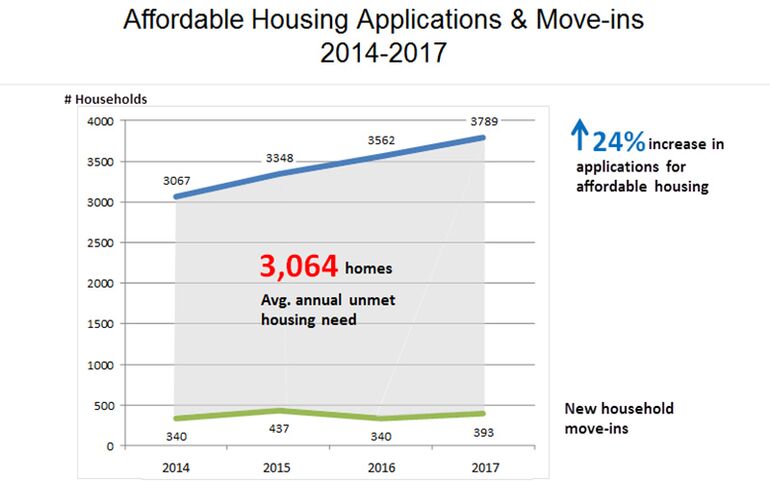Avesta report shows low-income housing shortage
 Courtesy / Avesta Housing
Chart shows the growing gap between the need for low-income rentals and availability of housing.
Courtesy / Avesta Housing
Chart shows the growing gap between the need for low-income rentals and availability of housing.
Applications for affordable housing to Avesta Housing, the largest nonprofit affordable housing provider in northern New England, have gone up by 24% since 2014, but the availability of housing for low-income renters has gone down, the organization said Thursday.
The company’s 2017 Affordable Housing Activity report shows a widening gap between how many families have applied for housing, and how many received it. The company received 3,784 applications in 2017 and had 393 move-ins. It’s waiting list has 1,594 individuals or families.
A report last year by the National Low Income Housing Corp. determined that Maine had 46 units available per 100 “extremely low income” renters. ELI renters are defined as at or below either the poverty line or 30 percent of the area median income can live without spending more than 30 percent of their household income on rent and utilities.
A lack of resources to build new apartments coupled with limited turnover added to the problem, a news release from the nonprofit organization said. It also said that the recently enacted federal tax reform bill will likely widen the gap, because it offers less incentive for construction of affordable housing.
The law lowers the corporate tax rate from 35 percent to 21 percent and changes the inflation factor for the Low Income Housing Tax Credit, making construction of low-income housing less profitable, according to Novogradac & Co., a CPA firm that has analyzed the tax bill.
Avesta has 84 properties housing 3,500 people in Maine and New Hampshire. Its average application was for a family of 1.74 with a median income of $14,400, which includes both those requiring rental assistance and those who don’t need it.
Of the 393 new households in 2017, 66% (259 households) required rental assistance in order to afford their housing, and their median household income was $11,436, according to Avesta. Accordingly, 34% (134 households) were able to afford their housing without the benefit of rental assistance, and their median income was $26,835.
The trend is a continuation of what Avesta reported at the end of the 2017 third quarter, when it said it had 2,077 on its waiting list.
“Avesta is committed to doing all we can to make sure that everyone has an affordable place to call home, but the ever-widening gap between the number of people who need our housing and the number of homes we have available represents a crisis that demands more, not less, public engagement,” said Dana Totman, president and CEO of Avesta Housing. “We hope that federal and state lawmakers will respond to the growing unmet housing needs in our communities with a growing commitment to addressing them.”










Comments